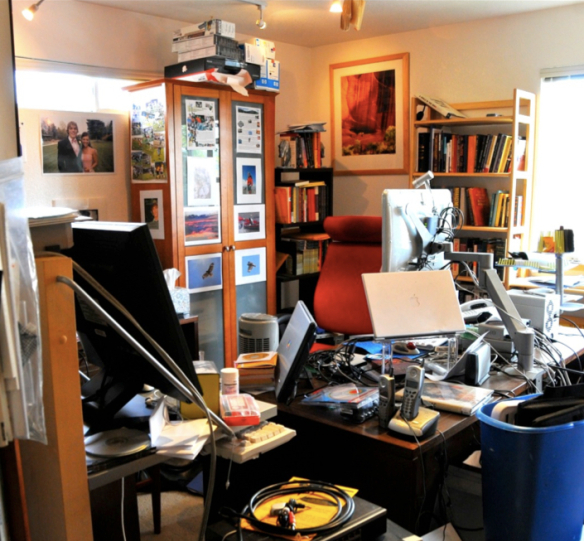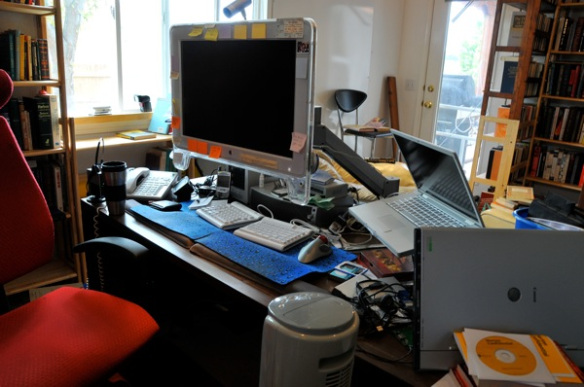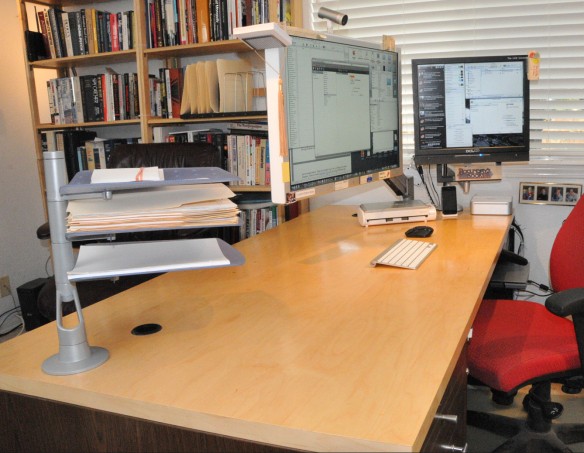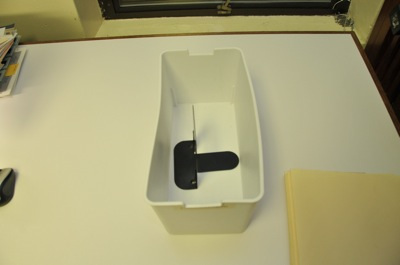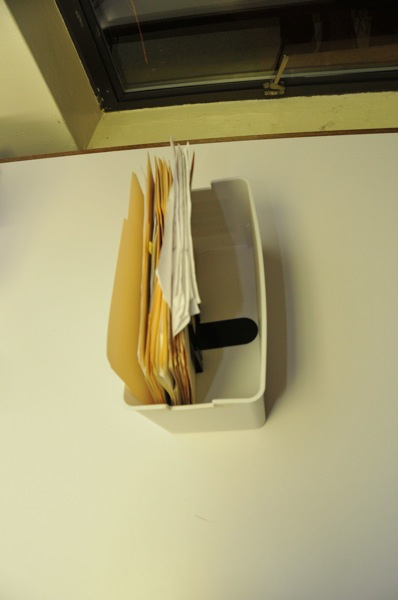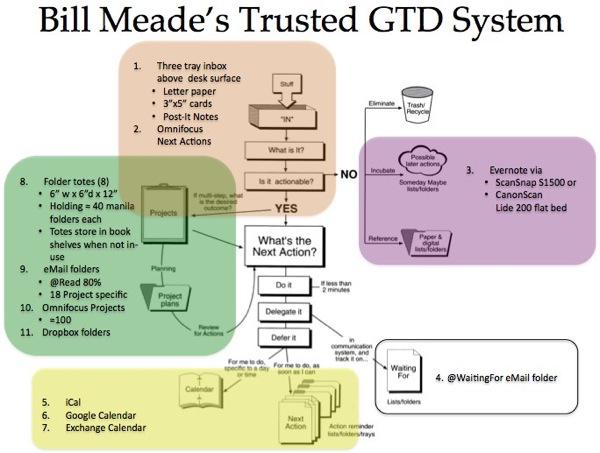From: Bill Meade [email protected]
Subject: Re: Thanks for blogging on Restart GTD
Date: October 30, 2012 1:11:07 PM PDT
To: Dave Findlay <[email protected]>
On Oct 30, 2012, at 4:32 AM, Dave Findlay <[email protected]> wrote:
Hi Bill,
Just thought I’d drop you a quick note to say Thank You! for writing your restartGTD blog. I’ve found it helpful with all the practical details of (re)implementing my own GTD system.
Thank you for writing. The blog is not beating the world for traffic, so I continue to write the articles I wish that I had read and could read. Every time I start down writing an article, I develop new GTD ideas. I’m having a blast. I’m glad you are enjoying it as well.
As a brief background on the GTD journey of one of your regular readers, I first found GTD at age 25 (I’m 29 now), when I was working as the sole paraplanner in a busy financial planning office. I found it through a search borne of desperation — I was working long days, had weeks of work piled up, no possibility of outsourcing or hiring extra help due to some extenuating circumstances within the company, and my huge backlog was starting to cost the company money. I figured I was a few weeks away from a nervous breakdown, and implementing GTD offered immediate and spectacular relief, even though I did it poorly at the time.
Since that first experience, my GTD adherence has waxed and waned over the following four years, meaning a month or so of great GTD hygeine, followed by a 6-12 week period of gradually slacking off, usually followed by some high-stress event, like missing a deadline or getting caught short somewhere and having to pull an all-nighter or work over a weekend, followed by an all-day session relocating the handlebars of my GTD system, etc. Kind of like the Book of Judges on repeat, hehe.
Since reading your blog, I’ve taken the plunge and sourced a ScanSnap S1500M, which has significantly streamlined my filing, and I’ve also switched email providers to make filtering and getting to Inbox Zero a much more common event (would have done this years earlier, but all the passable variants of my name in gmail were already taken). Inbox Zero now happens an average of once a week, in all personal and work email accounts.
By the way, this makes you a GTD black belt. I went to the official GTD seminar in Portland OR, last November and was surprised to find that I was a black belt! Only about 15% of the people attending the seminar implement anything like the full GTD suite of tools and habits. I had discussions with DavidCo last year that gave me that statistic.
I’ve noticed an interesting phenomenon recently when I do a good brain-dump and weekly review, where I get all email and physical inboxes to zero and get very clear on all my projects at 10,000ft, bring them up to date and recalibrate time-lines for the completion of ensuing steps … (and my weekly review still only happens on this level about once every 3-4 weeks, if I’m honest) … immediately afterwards, I get sick. It’s like my body has been amped up on stress for a period, and the clarity that a good review brings is enough to let my body down off its adrenaline-high, to an immune trough — I don’t want to accept the term “leisure sickness” just yet, but the experience is similar.
You are the second person to tell me this. My first thought is “Get up to, but no to, inbox zero.” Avoid the trigger, but capture most of the benefits.
It’s amazing how our minds and bodies get used to a certain level of dysfunction, and struggle when it’s eliminated. I’m examining my GTD system to see where the gaps are — I figure if I’m stressed enough to crash my immune system, then somewhere along the line I haven’t externalised all my open loops and agreements. My brain is still trying to handle them.
I have people who tell me that as they approach a panic-free work, that they get a new fear (?). The new fear is that the lack of chaos will kill their creativity. I think the reduced form equation for this is:
stress = creativity
Crazy! But, tell that to the inmates! They don’t have the receptors in their brans for the message.
Two of my MBA students who have gotten to inbox zero, task zero, and are fully caught up on work, have contacted me in terror to say “What do I do now?” Culture, school, watching our parents work hard as we grow up, a lot of our world conspires to program us to always be working … under stress.
/begin GTDessay
Think about it, how many unstressed people have you see at work in your life? The boss? Bosses may look serene on the outside, but on the inside they messes. Western cultures all teach “behind as normal” which makes little sense. The disappearing boundaries between work/personal, tast/project, team/individual in today’s knowledge work place seem to be tapping into the evolutionary trait of trying harder. Trying harder is a vestigil function, it makes no sense today to live perpetually trying harder today.
Come to think of it, I used GTD to get my work under control, and then I used GTD to double my work capacity, while proudly increasing the quality of my work. Perpetual “behind as normal” is not sustainable. I’ve been postponing the day of cut off. That day that David Allen talks about near the beginning of GTD where you “control what information gets into your life.” Control the inflow, control the system, control your life.
My next GTD problem is to figure out how to fix the thermostat needle for “enough” work. How do I decide enough is enough? How to I get a feedback signal to tell me that I’m too low or too high? When exercise ceases? When whimsical thinking ceases?
I think “behind as normal” thinking is what throws so many people off their GTD band wagons. It is just habit to lapse and then recede comfortabbly back into being behind with the rest of the herd. In Pressfield’s THE WAR OF ART he talks about humans being herd animals, and creative people having to convert themselves to turf animals. To picking some turf that they will live or die defending. Something like that tranformation is behind the need to restartgtd all the time.
/end GTDessay
Your thoughts would be welcome, but I understand you’re busy, so no pressure. Thanks again for writing such an helpful blog.
I appreciate the kind words and encouragement. May I post this email response on the blog? Most GTD users are closet users. You can’t survey them for what they need to hear to develop further. They won’t answer. So I keep trying to use every input possible to lay out fleeces that will resonate with readers. Your thoughts would be great to post!
Best Regards,
bill meade
p.s., Do you produce awesome Zinfandel in Toowoomba’s Darling Downs? Am I invited for some if I’m in the neighborhood? :-) I ran several invention workshops while working at HP, in Melbourne (mel-bunn).
Warm regards,
Dave Findlay
Toowoomba, Queensland

